BLOGS
Grow Healthy Plants Through Composting
This pandemic introduced us to the new normal where we spend more time at home. One of the major activities that helped us keep the lockdown fatigue at bay was growing healthy plants and tending to our gardens and indoor plants. Not only does it keep us busy during these uncertain times but it also allowed us to become full-fledged “plant parents” and grow a green thumb.
There are many ways to grow healthy plants because each kind of plant has a different requirement. Soil is one of the most crucial steps in growing plants because it holds the plant from its root and stores the nutrients for the plants to grow. Composting is a way to ensure that the soil you use has the necessary nutrients to grow your plant. Not only does it help produce healthy plants but also aids in sustainability efforts. These plants can help our mental health and improve and purify the air quality.
What is Composting?
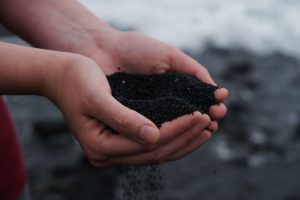
Composting is a means for producing nutrient-rich soil for plants.
Composting is the method of collecting food scraps and other materials that can be broken down and become a fertilizer for your plants. Not only does composting help grow healthy plants, but it also benefits our environment because segregating food scraps and other materials from our household waste prevents them from being dumped in landfills. Eliminating these materials in landfills can reduce the amount of carbon monoxide, methane, formaldehyde from the air, and greenhouse gases thus lessening our carbon footprint.
So you’re not only growing healthy plants but you’re also contributing to the environment. Interested to know how to compost? Let’s go find out!
Suggested Read: Low Maintenance Plants for your Luxury Condominium | Brittany
Step 1 : Choose Your Location and “Container”
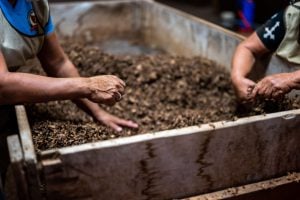
Knowing where to place your compost is an important step to beginning your composting journey.
The first step in preparing your compost is to choose where to place it. You can either have a compost bin or an open pile. If you have house plants, you can simply bury your food scraps and work your way from there.
It is also important to plan where to place your compost bin. The recommendation of experts is that you situate your compost near a water source and an area in your house that receives an ample amount of sunlight. You would want to avoid dried-out compost and too much sunlight may cause just that. You also want to avoid making your compost too wet. It is important to keep these elements balanced to have effective compost and ergo, have healthy plants.
Step 2: Choose What To Put In Your Compost to Grow Your Healthy Plants

What materials you put in your compost will make or break the growth of your healthy plants.
A crucial step in making compost is what you put in it. An easy rule to remember, you can separate them into kinds: green and brown. The proportion is also important so you must keep the ratio at 1:2 of greens to browns. Green refers to wet materials while brown refers to dry materials. I know what you might be thinking, what are the examples of greens and browns? We have you covered.
The green list consists of vegetable and fruit scraps, eggshells, coffee grounds, tea bags, and grass clippings to name a few. Meanwhile, the brown list consists of dead leaves, branches, tissues, newspapers, and even wine corks. These are just a few examples because there are plenty more.
It is important to take note if a material is considered compostable in the first place. You must be vigilant about what you include in your compost because one mistake can be detrimental to your growing plant. Proportion is also important because if you put too much decomposing material, your plants may be infected with diseases that can cause them to wither and die.
Suggested Read: VitaCare UniMed Contract Signing | Luxury Homes by Brittany
Step 3: Layering Them Down
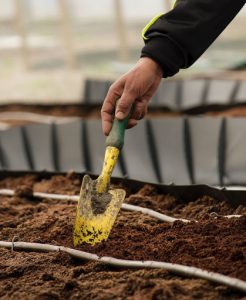
Putting the green and brown materials together in your bin is the start of the composting process.
Now that you are armored with what you put in your compost, it is now time to plan the spread and layering. There is no right or wrong way to do this, just make sure you combine all materials adhering to the recommended ratio. Experts suggest you should make your pile at least 3-ft deep.
If you want to be creative, you can try the lasagna layering technique when composting. Just as the name says, you can layer your green and brown materials as you would when making lasagna. Although the last layer must be brown materials as this will serve as a “protective layer” from insects.
If you observe that your compost is too wet, you should add more brown materials and vice versa if the compost is too dry. Remember to remove any food waste that has been cooked as it attracts vermin. Instead of aiding the growth of healthy plants, the compost might yield adverse effects on your plant.
Step 4: Ventilation and Drainage

Your compost bin must allow air circulation in order for microorganisms to break down the green and brown materials.
Your bin should allow air circulation. Ventilation is also an important step in creating your compost because oxygen is essential in decomposition. Turning or fluffing it like an expert can also maintain your good bacteria count. You can also poke some holes on the sides of your bin for extra air pockets to prevent the compost from storing too much heat from the metabolic activity.
You can also have additional air pockets by using sunflower stalks, sticks or corn in your compost.
Step 5: Watering Your Compost to Grow Your Healthy Plants
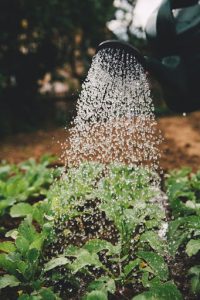
Watering your plants is vital to get them healthy
It is common knowledge that all life needs water. The same goes for our compost as the decomposition process needs water in order for the green and brown materials to be broken down. With the right amount of water, microorganisms will be able to function well and turn your compost to a plant-friendly fertilizer.
Water also regulates the temperature of your compost. As mentioned previously, the process causes heat and if water is not sufficient, it can cause dryness to your compost and in severe cases, cause fire.
The desired moisture level must be a “wrung-out sponge.” If the compost is too dry, add water accordingly. If it is too wet, then you must add more dry materials as needed. Healthy plants heavily rely on the moisture of the soil so it is important to know if the level of moisture is enough.
Step 6: “Stir” Your Compost
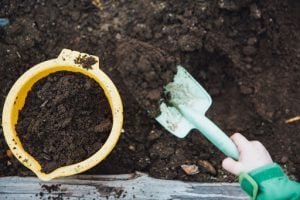
Turning your compost with the use of a garden rake or shovel will help speed up the breaking down of the process of your food and household waste.
After watering, stirring your compost is the next step.
Although there is no specific rule when it comes to stirring your compost, doing so every few days will fasten the decomposition process. This is highly recommended if you are trying to produce a large volume of compost. As a guide, you should only start raking your compost once your bin is full.
If you plan on producing nutrient-sufficient soil for your healthy plants, it is good to make them in a large volume since it does take time to fully decompose organic matter.
Final Step: Feeding Time
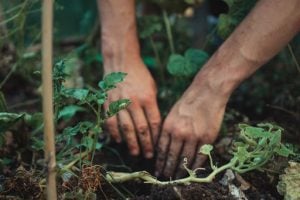
In order to assess if your compost was a success and is ready to be used to foster the growth of your healthy plants, you must check all the clues that indicate compost maturity.
After leaving your compost to do its magic, you check your bin and ask yourself, how would I know if my compost is ready to be used for my plants? Well, the answer there is simple. Once you open your compost and see that you no longer recognize the individual materials you have placed in it, it means your composting worked!
Another clue you need to look for is the smell. If your compost smells earthy, it means it is ready. You will also know if your compost has matured enough when it no longer produces heat. This signals that the decomposition process has been accomplished. Once you’ve checked all these indications, voila, it’s feeding time for your plants!
Healthy Plants For Life
Even though the topic of this article is centered on composting, the goal is to grow healthy plants for your home. Undeniably, growing plants became a fad in this pandemic to keep us occupied. But for other people, growing plants is more than just a hobby. It is scientifically proven that plants eliminate toxins in the air which is why it is ideal to have plants in your home.
Consider a snake plant, peace lily, or an aloe vera for your luxury home
Other than leisure and health purposes, plants also add aesthetic value to our homes. It adds character, personality, and sophistication. You can never go wrong with decorating your place with plants because it is sustainable, timeless, and relevant.
Similar to Brittany, our luxury homes are also sophisticated and timeless. Our properties are inspired by some of the world’s most scenic destinations. Nature-lovers will admire our homes and communities because of their closeness to nature. We in Brittany do not only want the best for our residents but also for our community and the environment.
NEXT READ: Elevate Your Luxury with Brittany’s Ultimate Luxury Playlist
NEXT READ: 5 Upcoming Furniture Designers to Follow




















